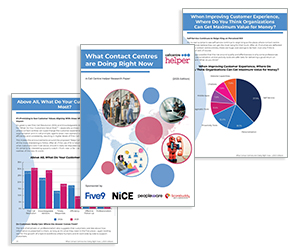Customer service roles come with a high level of emotional demand.
From managing difficult customer interactions to meeting performance targets and navigating complex systems, contact centre agents often operate under intense pressure.
So how can leaders help reduce stress and support their teams more effectively?
To find out what contact centres can do, we asked Ray Agar, SaaS Solutions Consultant at Peopleware (formerly injixo), to explain how increasing agent freedom and flexibility can help reduce agent stress.
Video: Increase Agent Freedom and Flexibility
Watch the video below to hear Ray outline how increasing agent freedom and flexibility can help reduce agent stress:
With thanks to Ray Agar, SaaS Solutions Consultant at Peopleware (formerly injixo), for contributing to this video.
This video was originally published in our article ‘Ease Agent Stress – With These 15 Top Tips!’
4 Ways to Implement Flexible Scheduling to Help Reduce Agent Stress
Supporting agent wellbeing doesn’t have to be complicated, even though working in customer service can be stressful:
“Customer service can be a stressful occupation, especially when it comes to handling difficult, and often emotionally charged customer contacts, as well as meeting targets, and working with technology.”
Introducing more flexibility into scheduling is a practical way to lower stress, boost morale, and improve performance in your contact centre.
Here’s how to do it effectively:
1. Ask Agents About Their Scheduling Preferences
It starts with listening. Simply asking agents when they prefer to work can uncover opportunities to align shifts with personal needs, and many are open to working outside traditional office hours if it helps them achieve better balance.
“One solution is to give the agents a say in their working times. Allowing your agents flexibility around their working times improves their work–life balance and can also lead to reduced stress levels.
This can be as simple as asking the agents about their working time preferences and taking those into account when building schedules.
Obviously, it’s not possible to grant every single request, but you might be surprised at how many people are willing to work outside the normal office hours if you ask.”
2. Use Workforce Management Tools to Enable Flexibility
Leverage features like self-scheduling, shift-bidding, and availability-based planning, as Ray explains:
“Of course, workforce management systems can help, with features like self-scheduling, shift-bidding, preferential scheduling, and agent availability scheduling.”
These tools give agents more control while ensuring the contact centre remains efficiently staffed.
3. Enable Self-Service Shift-Swapping
Once schedules are live, allow agents to swap shifts with each other through your WFM system.
“Once your schedules are published, offering things like shift-swaps on a self-service basis can also increase agent freedom and flexibility of options.
Giving the agents the option to swap shifts with their colleagues gives them the opportunity to adjust their schedule to match all those complex demands of their personal life, and this reduces stress levels associated with rigid scheduling.”
This reduces the stress of fixed schedules and empowers agents to manage changes independently when life happens.
4. Focus on Work–Life Balance to Reduce Pressure
The ultimate goal is to support agents in balancing their personal and professional responsibilities.
Flexible scheduling leads to happier, more engaged employees who are less likely to feel overwhelmed or burnt out.
If you are looking for more great insights from the experts, check out these next:
- The Secret to a Successful Tech Upgrade
- How Gamification Can Improve Scheduling
- The Benefits of Switching Up Your Agents’ Day
- How to Get Calls to the Right Agent, First Time
Author: Robyn Coppell
Reviewed by: Xander Freeman
Published On: 18th Jul 2025 - Last modified: 25th Sep 2025
Read more about - Video, Health Wellbeing and Stress, Peopleware, Ray Agar, Scheduling, Videos






































